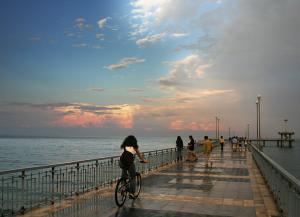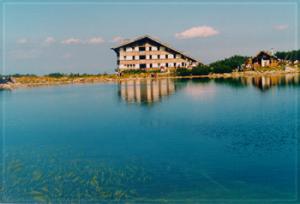Burgas Bulgaria, Information about Burgas
Burgas PropertiesBurgas is smaller and less crowded than Varna, it has a population of 210,260. It is Bulgaria's largest port and this is the primary focus of the city. Bourgas has a relaxed atmosphere with good shopping and an abundance of restaurants and outdoor caffes.
Bourgas is a successor of the late Roman small town called Deultum founded by Emperor Vespasian as a military colony for veterans. Later it was called Develt, which served as a name for the present day village of Debelt. Three more villages were included in the present day territory of the city, i.e. Kastiacion, Skafida and Rossokastron. Later a curative settlement was built called Aqua kalidae, arranged like Asclepionite around the mineral springs well known in the area. Thracian tribes lived here before the commencement of this construction work. The glory of the adjacent towns did not allow small fortresses to expand. In the Middle Ages a small fortress called Pirgos was erected, most probably used as a watch-tower in Bulgarian territories.
It was only in 17th century that Bourgas was given its present name and its location as it is now was determined. It was called Ahelo-Bourgas. After the Liberation it was called Bourgas, and was a small settlement with 2950 inhabitants. Ever since the town has grown and the population has increased almost 100 times. It became the centre of the Southern Black Sea coast, a city of well developed industry and trade, with a busy harbour. A number of plants, oil and chemical works producing more than 30 oil products for the country, were built; there was rapid agricultural development on the land by the city; salt and iron are mined in industrial quantities and trades far beyond the boundaries of the country. In 1903 the railway station in Bourgas started functioning.
The District Museum of History was founded in 1925 with the archaeological association. Today it houses an archaeological hall with a rich collection from the old colonies on the Black Sea coast. There are a number of ceramic vessels, objects from everyday life, coins and jewellery from antiquity, tombstones, plates of Thracian horse-riders, tools, and miniature models of ancient settlements. There are exhibits of modern history, photos of Revival eminent leaders, of Bulgarians born in the district having blazed a trail in the history of the native land.
The Sea Park is situated on a high shore, all of it cut by flowerbeds, trees and sculptures. There is the bust of Adam Mizcewic, Polish writer and revolutionary, who stayed in the city in 1850.
 Within the park there is the casino, a small zoo and the open-air theatre, which houses the annual International Folklore Festival, and where part of the guests at the Golden Orpheus Pop-Festival perform.
Within the park there is the casino, a small zoo and the open-air theatre, which houses the annual International Folklore Festival, and where part of the guests at the Golden Orpheus Pop-Festival perform.The central beach is situated below the Sea Park, a beautiful forked staircase in verdure leads to the beach. The sand is a mixture of various alloys of magnetite which are the reason for its dark colour. The city has a northern beach, too, close to the Izgrev Quarter, adjacent to the salt-mines.
The St. Cyril and Methodius Cathedral is situated near the marketplace, and is interesting for its marvelous frescos and wooden altar. The Ethnographic Museum has an interesting collection of traditional masks of koukeri, and costumes typical of the region, objects from everyday life, and ritual accessories. There is a video-hall where one can see ethnographic and historical films. A number of traditional Bulgarian fabrics and embroidery typical of the district are exhibited. The museum is arranged in a house from 1873, later declared a cultural monument.
The Philharmonic, the Opera House, and the Theatre of Drama are housed in three different buildings and function all through the season. Together with the Puppet Theatre they outline the cultural atmosphere in the city with their interesting concerts and performances. An interesting sight of Bourgas is the Armenian Church located close to the Bulgaria Hotel. It was built in 1855 by the local Armenian minority supported by Bulgarians.
There are numerous festivals and holidays held in the city of Bourgas: Five days of the Classical German and Austrian music - at the end of April; International Festival of Children?s Choirs - end of May; International Theatre Festival of Small Forms called ?Theatre in a Suitcase? - May, June; Three-week Festival of Opera and Classical Music in Memory of the conductor Emil Chakurov - July; International Folk Festival and A Week of the Arts for Children - August; International Pop- and Jazz- Session called ?Bourgas and the Sea? - September; International Tournament in Standard and Latin-American Dances - December.
The city has many hotels of different categories, many private lodgings, there are two big camping sites in the proximity of Bourgas. The cheapest accommodation is found in the private hotels in the suburbs.
The city is full of restaurants, pubs, beer-houses, taverns, and refreshment stalls and grocer?s shops. Most of the luxury restaurants have orchestras playing, some offer entertainment, too. As a rule the food in the city is cheap, especially if one shops in the suburbs or at the marketplaces. The practical tourists may use the services of the traditional bakeries, pizza houses, and self-service establishments.
Bourgas Airport is open for flights from the country and abroad through the year. There are flights to Sofia every day, and during the summer there are up to 7 flights in the day in both directions. The flight to the capital city takes 40 min. The railway station in Bourgas has connections with all main directions round the country. The express train to Sofia travels less than 6.30 hours; it takes 3 hours to get to Plovdiv. Reservation in a sleeping car should be made at least a week earlier during the summer. The bus station is located next to the railway station. Buses in many directions including Sofia start from there. There are a lot of private carriers to the south and to the north of Bourgas to the towns and resorts situated some about 50 km away from the centre. There is regular city transport - buses, trolley-buses and route taxis.
 The lake of Pomorie is located 20 km north of Bourgas and is surrounded by salt-mines and balneo-resorts. Atanassovo Lake is to the north, too, between the airport and the city. It is 10 km long and is a nestling site of many marsh and sea birds migrating from Gibraltar and the Bosphorus. Part of the lake is a biosphere reserve; bulrush and cane grow here, there are sites for fishing, swimming and having a rest. Bourgas Lake is a nestling site of numerous pelicans, ibis, and herons. It offers many opportunities for having a rest as well. Mandren Lake is 10 km south of the city and is also an important ornithological reserve with a large bird population in summers. Small lagoons have been formed in it; it is appropriate for rowing tours and recreation. The lake is close to the road to Sozopol.
The lake of Pomorie is located 20 km north of Bourgas and is surrounded by salt-mines and balneo-resorts. Atanassovo Lake is to the north, too, between the airport and the city. It is 10 km long and is a nestling site of many marsh and sea birds migrating from Gibraltar and the Bosphorus. Part of the lake is a biosphere reserve; bulrush and cane grow here, there are sites for fishing, swimming and having a rest. Bourgas Lake is a nestling site of numerous pelicans, ibis, and herons. It offers many opportunities for having a rest as well. Mandren Lake is 10 km south of the city and is also an important ornithological reserve with a large bird population in summers. Small lagoons have been formed in it; it is appropriate for rowing tours and recreation. The lake is close to the road to Sozopol.St. Anastassia Island is 3 nautical miles east of the city. There is a well-preserved old church. The name of the island is associated with the exile of left-wing revolutionaries in 1923-1925, and of anti-Fascists in 1943-1944. That is why for some time after 1944 the island bore the name Bolshevik.
The salt-mines of Bourgas are a sight of interest. They border the Bourgas Lake, and some of them even stretch to the Atanassovo Lake. The mineral public baths are 13 km north-west of the city in the direction to Aitos. There are the remains of the old Roman town called Aetos built round the mineral springs. The settlement near the baths was called Terma, Termopolis, Megaliterma. In 16th century a Turkish hamam (bath) were erected; it is still existing and functioning. There is curing mud, a balneo-spa, a resort polyclinic, and a rest home.
The village of Kraimorie (old name Kafka) is to the south of Bourgas on the way to the old fortress of Pirgos. There is a nice beach near the village, as well as rest homes and private lodgings for the holiday-makers. The Otmanli Park is 15 km away from Bourgas near Cape Choukalya. It is situated in a thick forest on a territory of 6000 decares. There is a hunting reservation and bungalows for recreation.
Burgas Properties

